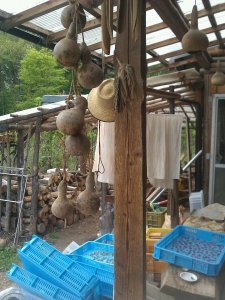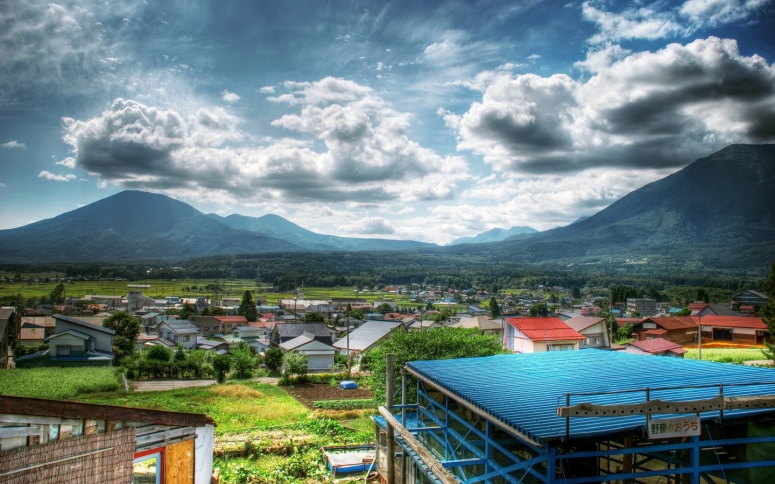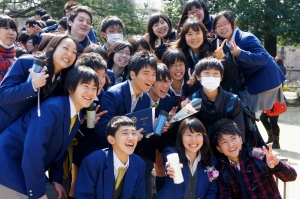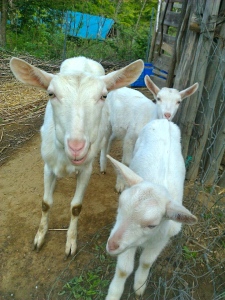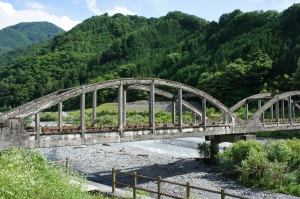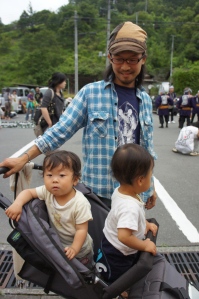Here’s the fourth chapter of my mini-adventure story. To briefly summarize my previous three posts, I have arrived in the tiny village of Ooshima in Nagano Prefecture after a long and hair-raising day of travel, attended a festival and chugged up a muddy mountain in a broken-down van. I have met Hiromi and Geta-san, owners of the organic farm called the Fresh Start School, and heard the story of their daughter Haru; she and her husband Junpei fled Tokyo with their newborn twin boys after the Great East Japan Earthquake and have remained on the farm since then. I have feasted on fried cubes of goat cheese, hearty miso soup, brown rice and beans, and some unidentified but delicious greens…..and that is where today’s post begins.

Solar panels on the main house are clearly visible from this vantage point ( or at least they are if you enlarge the picture).
So let me start off this new post with a description of the main house at the Fresh Start School. Upon first glance, the large wooden house appears to be thrown together rather than constructed, but although the wood is weathered and unfinished, a closer look reveals that it is in fact quite nicely built. “It’s sturdier than it looks,” my daughter had assured me, and I trusted that it was. Solar panels attached to the roof produce more than enough power to run the household. “I can’t be bothered with batteries big enough to store all that power, ” admitted Geta, ” so I sell it to the local electric company instead. Then I buy back from them the small amount that our family needs. Heh-heh. Cheap and easy. ” So in fact the Fresh Start School IS connected to the grid, but just barely. The rest of the farm is self-sufficient.
The veranda is chock full of potted flowers, rubber boots, hanging laundry, hanging gourds, milk crates, and a glorious mishmash of containers and baskets full of mysterious contents. I wondered how they got all these items indoors in a hurry before a typhoon, but did not ask. And from the crazy and colorful chaos of the veranda, the door opens into the main living area, a large central space used for cooking, dining, and relaxing.
My immediate impression of the interior was of a combination Indian bazaar and dimly-lit-but-inviting used bookstore. Naked light bulbs hung from the ceiling, one in each area, revealing floor to ceiling shelves literally stuffed with books (overflows stacked on the floor), as well as statues and souvenirs from various countries. The “entertainment system” consisted of an old analog TV and a dusty shelf of videocassettes. The main room looked to be heated by a good-sized wood stove into which the babies had been peering during our dinner, sifting through the ashes and experimenting freely. Two well-worn sofas with a rough hewn coffee table in between formed a cozy nook for reading or conversation.
The dining area consisted of two low coffee tables pushed together, and the kitchen was a rather uninviting dark alcove with a small sink from which cold water flowed, a gas stove with pull-out fish grill, and a wooden center island heaped with jars of pickles, sauces, teas and condiments. No store-bought salad dressing, jam or boxes of tea, as literally everything stored (or jumbled together) in the kitchen area had been made from ingredients grown or found on the farm and concocted by Hiromi, Mama Haru or one of the acolytes who come and go according to the season. “Well, what about things like soy sauce?” you ask. The answer is the same. Shoyu is home-made, beginning with the soy beans, which are then harvested, cooked, mixed with flour, allowed to ferment and become moldy, and finally squeezed into liquid through a cheesecloth. The whole process takes from six months (according to Wikipedia) to several years (according to my daughter, who insists that the fermentation process cannot be completed so quickly) and is not for the faint of heart who, I surmise, do not last long at the Fresh Start School.
And now for the bathroom! It was set off from the kitchen in its own private space below the staircase leading to Geta and Hiromi-san’s bedroom. Pushing open the door, the standard Japanese bathroom slippers are set out, and a quite regular-looking porcelain toilet sits squarely in the middle of a good-sized room. The quite regular-looking toilet also has the standard fuzzy knitted seat warmer (readers abroad must imagine it), and only the smell gives a clue that this is actually a composting toilet–no flush, no pipes, and a deep hole in the ground at the bottom. The toilet is set with its back toward the door, facing a long shelf attached to the wall. The shelf , which is laden with tiny objects, is the perfect level for viewing when perched on the toilet seat; one can relax and contemplate shells, leaves, small trinkets, and carved wooden objects several times a day, and presumably the odor gets easier to ignore over time. I was delighted to spy a small wooden bird that resembled one of my daughter’s creations among the objects set out for viewing, and Hiromi later confirmed that this was so.
My obsessively neat mother-in-law and most of my Japanese housewife friends would consider the entire interior of the house “migurushii” , or “painful to look at”, simply because things were out in the open rather than stored neatly away in cupboards or closets. “Oh, the dust!” they would say. And no doubt, any potential acolyte with a house dust allergy would not last 30 minutes inside the main house. Me? I was fine. Like the babies, my eyes were pulled this way and that as I admired knick-knacks, peered into containers, and strained to read book titles in the dim light. Dust was inconsequential.
Of course, unlike the babies, I took care to appear casual and polite rather than open-mouthed and curious. I was also desperately in need of sleep, stifling my yawns with only mixed success. Hiromi, noting my distress, remarked, “Hmmmm….where should we put you tonight? ”
I immediately offered to sleep in the same cabin that my daughter had used the previous month, if it was available.
“I don’t know…it’s really….primitive…” said Hiromi doubtfully (testing me?).
This, of course, caused my spine to straighten automatically as I protested, “No, no, I’ll be fine! Just point me in the right direction!” ( Is she intimating that I’m a Princess? I can do “primitive” with no problem. I’m just out of practice, that’s all…)
“Good, good. The cabin is just past the Octagonal House. Follow the path and you’ll find it, even in the dark, ” said Grampa Geta-san cheerfully. He had taken out his false teeth with a great sigh of relief and looked ready for bed himself.
So I set off alone into the black night, wondering exactly what my landmark was, as I had not understood “Octagonal House” in Japanese. Really, it does not come up in everyday conversation. Squelching down the muddy path in my rubber boots, I made my way toward what appeared to be a lighted building (I did not notice its unique shape as I passed by, though from the sounds I understood that Haru, Junpei and the babies lived here) and literally bumped into my destination, which was a tiny shack at the end of the path. My room for the night.
There was no knob, no latch and the door was not tightly fitted. I simply pulled it open and stumbled in, fumbling to get out of my muddy boots. Thankfully, I could make out a lightbulb with a string attached, and thankfully it worked when I gave it a hopeful tug. I took stock of my surroundings in the light: enough room to set my backpack on the floor, a flimsy shelf for my glasses and iPhone, and a ratty-looking futon laid out on a wooden pallet. Literally no room to move about, so sleeping was the only option here. “This is the cabin that my daughter adored,” I thought, seeing her through new eyes. By the foot of the futon was a pile of rather musty-smelling quilts which I spread out, ignoring the odor. At this point, any aesthetic preferences were pointless and I only hoped to spend a pain-free and relatively comfortable night.
Now I am not only a good sleeper but I am a determined sleeper as well, especially when faced with the prospect of an early morning in unfamiliar circumstances. So without bothering to change into fresh clothes I fell into my makeshift bed, pulled up the covers, and was sound asleep within a matter of minutes.
The first few hours were blissful. Or I assume they were, as I have no memory of them. I cannot, however, forget my rude awakening at an ungodly hour by a hoarse cry that seemed to come from outside my window. Despite being sleep-befuddled, I soon identified it as….a rooster! Wait–roosters mean morning! ….Was it morning?? ….Where was my iPhone? And I had to pee!! ….Suddenly, I was wide awake, and fumbling for my faithful iPhone, which read 3 a.m. Noooooo. I stumbled into my rubber boots, pushed open the door, and immediately wished for a penis. It was seriously cold, and the grass was high and wet. I did my best to pee neatly and discreetly (the rooster might be watching) in the muddy grass outside the cabin. Then back inside, out of the boots again and into bed, I determined to return to sleep. I am good about being able to do that.
This time, however, my determination was most severely tested by the rooster, who had convinced himself that it was morning and was now obligated to alert the rest of the world. The persistant fowl squawked and crowed intermittently until at last it truly WAS morning, at which point he was joined by a chorus of bleating goats. And then I knew that I was up for the day as well.
So passed my first and only night at the Fresh Start School. Having spent the last few hours in a torturous cycle of sleeping and waking, I gave up the fight. Shouldering my backpack and grabbing my glasses and phone, I and threw open the door to the cabin to face the day ahead. My daughter had warned me that bathing was an “event” occurring every third day since bathwater had to be heated by making a fire, so I knew there would be no refreshing shower to start the morning. Instead, I trudged back through the squelching mud and up to the main house, where I would spend the day working at whatever tasks were set out for me. But that will be my next and final post. Until then, take good care and thank you again for reading.
